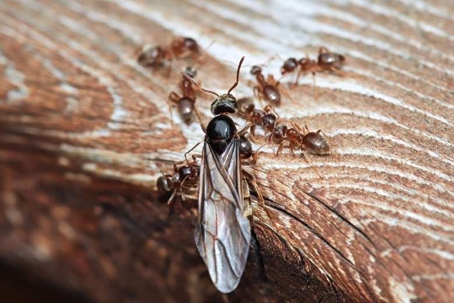Do Field Ants Bite?
Field ants, which typically include species like Lasius spp. and Formica spp., are generally not aggressive toward humans or pets. However, bites can occur in specific situations:
Nest Disturbance: The most common trigger is accidental disturbance of their nest, whether outdoors in soil, under rocks, or in decaying wood. Stepping on a nest, digging, or moving objects covering their colony can provoke defensive biting.
Protection of Larvae or Food: Field ants may bite if they perceive a threat to their brood (larvae and pupae) or stored food. This is more likely if pets sniff or paw at ant mounds.
Foraging Encounters: While foraging, these ants may bite defensively if handled or crushed accidentally. This is uncommon but possible, especially if a child or pet interacts with foraging ants.
High Population Areas: When field ant colonies are dense or aggressive species are present (like certain Formica species), the likelihood of incidental bites increases if people or pets come into frequent contact.
Field ants rarely bite unprovoked. When they do bite, it’s usually a mild, quick pinch, though some species may spray a formic acid irritant, what can cause temporary burning or redness.
Field Ant Bites
Field ant bites are generally considered low-risk compared to bites from more aggressive or venomous insects, but there are still some potential concerns:
Local irritation: The most common reaction is redness, itching, or a mild burning sensation at the bite site. Some field ants, especially Formica species, can spray formic acid, which can cause temporary stinging or irritation.
Minor swelling or blistering: In sensitive individuals, bites can lead to small raised bumps or tiny blisters. These usually resolve within a few hours to a day without treatment.
Allergic reactions: Although rare, some people or pets may experience an allergic response, ranging from mild (hives, increased itching) to severe (difficulty breathing, swelling of lips/tongue, anaphylaxis). Severe reactions are uncommon with field ants but are possible in highly sensitive individuals.
Secondary infection: Scratching bites can break the skin, creating a risk of bacterial infection (redness, warmth, pus). Proper cleaning of the bite site is usually sufficient to prevent infection.
Discomfort for pets: Pets may react by licking or scratching the bite area, which can worsen irritation or introduce infection. In very rare cases, multiple bites could cause mild systemic effects like temporary lethargy or mild swelling, especially in small pets.
Field ant bites are mostly nuisances rather than serious hazards, but they can cause discomfort and, rarely, allergic or infectious complications.
What Do Field Ant Bites Look Like?
Field ant bites are usually mild and easy to distinguish from bites of more aggressive ant species. Key characteristics include:
Small red bumps: The bite typically produces tiny, raised, reddish spots, often no larger than a pinhead. They may be slightly inflamed or warm to the touch.
Localized swelling: There may be mild swelling around the bite, but it is generally minimal. Unlike fire ants, field ant bites rarely form large, fluid-filled pustules.
Stinging or burning marks: Some species, like Formica, can spray formic acid, leaving a small area of redness with a burning sensation. This may look like a tiny red patch with a central pinpoint where the ant bit.
Clustered bites (occasionally): If multiple ants bite at once (for example, after disturbing a nest), you might see a small cluster of bites, often in a line or group.
Temporary appearance: Most field ant bites fade within a few hours to a day. Minor itching or irritation may persist for slightly longer.
Unlike bites from fire ants or carpenter ants, field ant bites rarely blister, ooze, or leave permanent marks.
What To Do About Field Ant Bites
If you are bitten by field ants, the bites are usually mild, but proper care helps reduce discomfort and prevent complications:
- Clean the area immediately: Wash the bite site with soap and cool running water to remove any dirt or residual ant acid. Pat dry with a clean towel.
- Reduce itching and swelling: Apply a cold compress or ice pack wrapped in a cloth for 10–15 minutes. Use over-the-counter anti-itch creams (like hydrocortisone) or calamine lotion if itching persists. Oral antihistamines (such as cetirizine or diphenhydramine) can help with itching or mild allergic reactions.
- Avoid scratching: Scratching can increase irritation and risk of infection. Trim fingernails and keep the area clean if you accidentally scratch.
- Monitor for signs of infection: Watch for increasing redness, warmth, swelling, pus, or tenderness. If any of these occur, seek medical attention as antibiotics may be needed.
- Watch for allergic reactions: Rarely, some people may experience severe reactions, including difficulty breathing, swelling of lips/tongue, hives, or dizziness. Call emergency services immediately if these symptoms appear.
- Prevent future bites: Avoid disturbing ant mounds. Wear shoes and protective clothing when walking through areas with visible ant activity. Keep pets away from ant nests.
For most people, field ant bites resolve on their own within a few hours to a day, with only minor discomfort.

